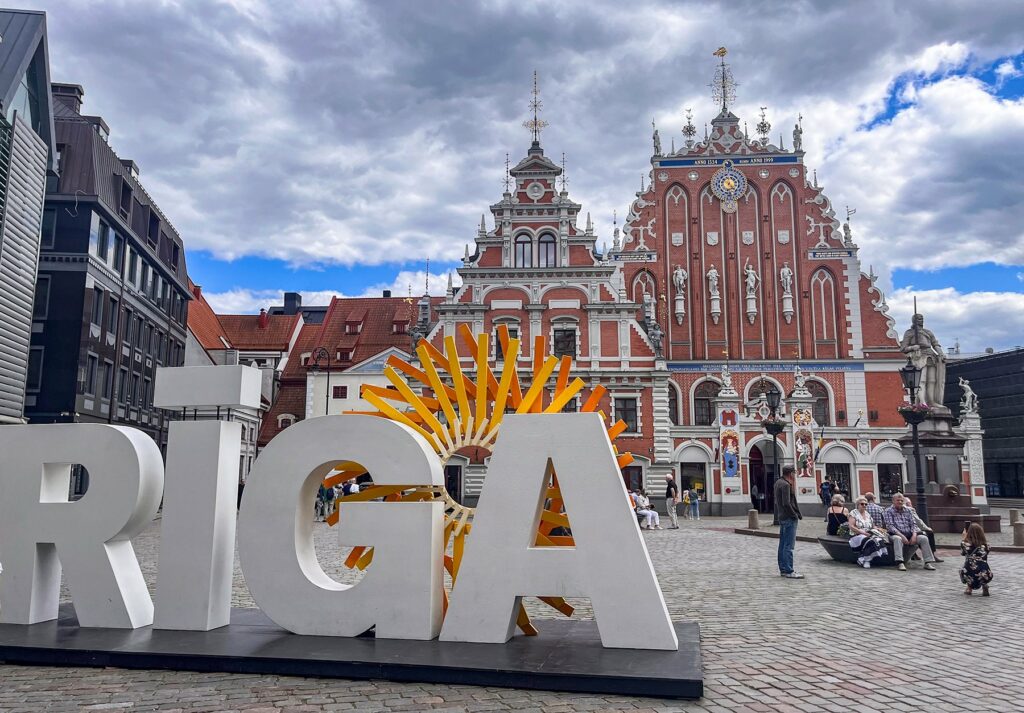The stark, obelisk-like Museum of the Occupation of Latvia stands among the historic buildings of Old Town Riga.
I learned this as I toured the Museum of the Occupation of Latvia, built inside an ominous concrete obelisk on the edge of beautiful Old Town Riga. The museum takes visitors on a chilling journey through decades of persecution by the Soviets and the Nazis, who initially made a devil’s deal to divide up Eastern Europe.
Then the Nazis attacked anyway, taking Latvia from the Soviets, deporting its Jews and starving its intellectuals. When the Soviets returned as World War II ended, they resumed deportations of Latvians as they attempted to replace the Baltic nation’s culture with the Russian language and devotion to communism.
At the Museum of the Occupation of Latvia, a round screen introduces visitors to the era of dictators and oppression.
The museum details the decades of repression and suffering that followed, until Latvia regained its independence in 1991. It also holds signs of hope — copies of underground newspapers, signs used by resistance movements. As an inscription near the museum’s entrance reads, “Through the labyrinth of darkness leads a thread of light.”
A display in the Museum of the Occupation of Latvia simulates the boxcars used to transport Latvians to Siberia during the 1940s.
Those words echoed in my mind as I sat at a kitchen table in a Latvian apartment, some 4,500 Sundays after that fateful Sunday in 1940. Only five of us, including minister Victor Barviks and myself, gathered there to worship. A few more joined us online.
Related: As Christians in the Baltics watch Russia’s war in Ukraine, they ponder: Are we next?
I shared photos and stories from my trip to Ukraine. I told them that God always is with us, in congregations great and small. When we feel like there aren’t enough of us for God to be able to use us to do his will, that’s exactly when God can use us. That’s what he did with Noah and his family, with Gideon and his army.
Viktor Barviks, left, and Ivars Landorfs worship on a Sunday morning in Riga, Latvia.
After worship, we shared a salad of pickled herring, onions, beets and potatoes. Its name translates as “herring in a fur coat.” Latvians must have Scandinavian blood. They think herring goes with everything. I also tried kvass, a malt beverage that tastes like liquid rye bread. I opted to stick with my Coke Zero.
The Church of Christ here had more than 40 members at one point in the 1990s, the heyday of evangelism in post-Soviet Europe. The church rented space in Riga’s first high school, and later moved to a room in an ornate, Soviet-era building in Old Town Riga modeled after the Seven Sisters — Stalin-era skyscrapers in Moscow. I had just come from Warsaw, Poland, where there’s an almost identical building. Barviks calls Riga’s “The Ghostbusters building.”
Erik Tryggestad gets a look at the Stalin-era “Ghostbusters building” in Riga, Latvia.
Barviks, whose parents are Latvian, grew up in California and first encountered Churches of Christ as a student at the University of California, Irvine. He worshiped with an International Church of Christ, then called the Boston Movement, before he moved to a mainline congregation. He moved to Riga in the mid-1990s. He married a Latvian and helped the young Church of Christ grow.
Since the 1990s, interest in the church has waned as members have moved away or passed away. “I’ve done so many funerals,” Barviks told me.
Old Town Riga.
There is hope here — Camp Hope, specifically. Barviks and church members from the U.S. coordinate the annual event that introduces children — including orphans and foster youths — to Christ. Barviks also ministers to people in prison and produces video Bible lessons in Latvian on YouTube.
Related: Camping for Christ in Lithuania
I’d been to Estonia and Lithuania, but this was my first trip to the “middle child” of the Baltic nations. Mission-minded Christians including Royce Sartain and Keith Levy launched pioneering efforts in the Estonian capital, Tallinn, and in Lithuania’s capital, Vilnius. The Waterview Church of Christ in Richardson, Texas, the Gateway Church of Christ in Pensacola, Fla., and the Levy Church of Christ in North LIttle Rock, Ark., have supported mission work in Estonia and Lithuania.
Children bow their heads for a prayer after a late-night devotional at Camp Ruta, a Christian camp for children in Lithuania, in 2008.
Latvia hasn’t had quite the attention. Barviks has labored largely on his own for more than three decades now. Another missionary who worked with a small congregation in Riga returned to the U.S. around 2008.
Ukrainian refugees in Latvia need spiritual support. So do the many young, spiritual seekers. Ministry opportunities abound along the cobblestone streets of historic Riga. Barviks said he’d welcome the help. I pray that believers will grasp that “thread of light” in Latvia and become a blessing to these people who have kept hope alive through decades of brutal dictatorship.
The sun sets over the Daugava River in Riga, Latvia.
Theirs is “a story about oppression, terror and violence” according to an inscription in the Museum of the Occupation, “about defiance, resistance and heroism; but also — about helplessness, fear and betrayal.
“Above all, however, this is a story of … stamina and spiritual strength.”
ERIK TRYGGESTAD is President and CEO of The Christian Chronicle. Contact [email protected], and follow him on X @eriktryggestad.
Source link : http://www.bing.com/news/apiclick.aspx?ref=FexRss&aid=&tid=67100e17735047a696b011bd8073a68b&url=https%3A%2F%2Fchristianchronicle.org%2Fgodblesslatvia%2F&c=12951848532417127250&mkt=de-de
Author :
Publish date : 2024-10-16 11:35:00
Copyright for syndicated content belongs to the linked Source.
